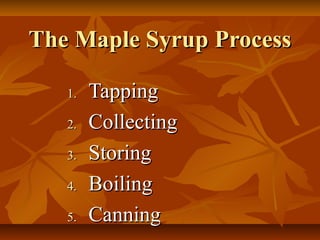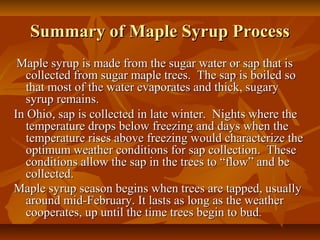The Maple Syrup Process at Johnson Sugar Camp
- 1. The Maple Syrup ProcessThe Maple Syrup Process 1.1. TappingTapping 2.2. CollectingCollecting 3.3. StoringStoring 4.4. BoilingBoiling 5.5. CanningCanning
- 2. Summary of Maple Syrup ProcessSummary of Maple Syrup Process Maple syrup is made from the sugar water or sap that isMaple syrup is made from the sugar water or sap that is collected from sugar maple trees. The sap is boiled socollected from sugar maple trees. The sap is boiled so that most of the water evaporates and thick, sugarythat most of the water evaporates and thick, sugary syrup remains.syrup remains. In Ohio, sap is collected in late winter. Nights where theIn Ohio, sap is collected in late winter. Nights where the temperature drops below freezing and days when thetemperature drops below freezing and days when the temperature rises above freezing would characterize thetemperature rises above freezing would characterize the optimum weather conditions for sap collection. Theseoptimum weather conditions for sap collection. These conditions allow the sap in the trees to “flow” and beconditions allow the sap in the trees to “flow” and be collected.collected. Maple syrup season begins when trees are tapped, usuallyMaple syrup season begins when trees are tapped, usually around mid-February. It lasts as long as the weatheraround mid-February. It lasts as long as the weather cooperates, up until the time trees begin to budcooperates, up until the time trees begin to bud..
- 3. Prior To TappingPrior To Tapping Before we tap the trees, we first distribute the buckets throughoutBefore we tap the trees, we first distribute the buckets throughout the woods so that they are ready to hang as trees are tapped.the woods so that they are ready to hang as trees are tapped.
- 4. TappingTapping Tapping refers to the process of drilling a hole or holes into theTapping refers to the process of drilling a hole or holes into the trunk of a tree to allow for the collection of sap or sugar water.trunk of a tree to allow for the collection of sap or sugar water. We drill a 7/16" hole in the tree, approximately 2 1/2 to 3 inchesWe drill a 7/16" hole in the tree, approximately 2 1/2 to 3 inches deep. New holes are located about six inches from a previousdeep. New holes are located about six inches from a previous season’s taphole. Trees should be allowed to grow to at least 12"season’s taphole. Trees should be allowed to grow to at least 12" in diameter before they are tapped. When a taphole is drilled, sapin diameter before they are tapped. When a taphole is drilled, sap will start to drip from it almost immediately. We then insert awill start to drip from it almost immediately. We then insert a spile into the taphole.spile into the taphole.
- 5. The spile that is inserted into the taphole directs the sap into aThe spile that is inserted into the taphole directs the sap into a bucket or pale and also serves as the hanger for the bucket. Whenbucket or pale and also serves as the hanger for the bucket. When the weather cooperates and the sap runs, it is then necessary tothe weather cooperates and the sap runs, it is then necessary to collect the sap.collect the sap. TappingTapping
- 6. CollectingCollecting We use a very traditional method to collect sap, much like we didWe use a very traditional method to collect sap, much like we did 50 years ago. Sap runs from the trees through short metal spiles50 years ago. Sap runs from the trees through short metal spiles into buckets hanging from the tree. We use a tractor and sapinto buckets hanging from the tree. We use a tractor and sap wagon to “haul” the sap.wagon to “haul” the sap.
- 7. CollectingCollecting Workers walk from tree to tree pouring the sap into 5-gallonWorkers walk from tree to tree pouring the sap into 5-gallon buckets and then pour from the larger buckets into the storagebuckets and then pour from the larger buckets into the storage tank located on the sap wagon. With 5-7 workers accompanyingtank located on the sap wagon. With 5-7 workers accompanying a sap wagon, “hauling” can be a very enjoyable task.a sap wagon, “hauling” can be a very enjoyable task.
- 8. StoringStoring When the storage tank on the sap wagon is full, the driver takesWhen the storage tank on the sap wagon is full, the driver takes it to the water shed to unload. The sap is strained as it isit to the water shed to unload. The sap is strained as it is emptied into a large, below ground storage tank. After emptyingemptied into a large, below ground storage tank. After emptying the sap wagon, the driver returns to find the crew to fill upthe sap wagon, the driver returns to find the crew to fill up again. Depending on the weather, it might be necessary toagain. Depending on the weather, it might be necessary to collect sap on consecutive days or just once or twice a week.collect sap on consecutive days or just once or twice a week.
- 9. BoilingBoiling The next step in processing the sap into maple syrup is theThe next step in processing the sap into maple syrup is the boiling stage. Boiling of the sap is done in an evaporator. Weboiling stage. Boiling of the sap is done in an evaporator. We use a wood-fueled fire and an evaporator that is 5 feet wide anduse a wood-fueled fire and an evaporator that is 5 feet wide and 16 feet long. A forced-air fire system allows the fire to burn at a16 feet long. A forced-air fire system allows the fire to burn at a higher temperature and decreases the amount of ash to behigher temperature and decreases the amount of ash to be removed from the stove.removed from the stove.
- 10. BoilingBoiling The sap flows into theThe sap flows into the evaporator pans by way of aevaporator pans by way of a float valve, maintaining aboutfloat valve, maintaining about 1 1/2 inches of sap in the pans1 1/2 inches of sap in the pans at all times. Water evaporatesat all times. Water evaporates from the boiling sap, makingfrom the boiling sap, making the sap denser and sweeter asthe sap denser and sweeter as it flows around the partitionsit flows around the partitions in the evaporator. The pansin the evaporator. The pans are designed in a way to forceare designed in a way to force the sap to flow back and forththe sap to flow back and forth as it is boiling, creating a longas it is boiling, creating a long narrow path for the sap tonarrow path for the sap to flow through. As the sap isflow through. As the sap is flowing through the pans it isflowing through the pans it is making the transition frommaking the transition from sap to syrup.sap to syrup.
- 11. BoilingBoiling When the syrup reaches the correct density of 66% sugar solids, itWhen the syrup reaches the correct density of 66% sugar solids, it boils at 7 degrees Fahrenheit above the boiling point of pure water.boils at 7 degrees Fahrenheit above the boiling point of pure water. When the syrup reaches the correct temperature a valve is releasedWhen the syrup reaches the correct temperature a valve is released allowing the syrup to flow out of the evaporator. The maple syrupallowing the syrup to flow out of the evaporator. The maple syrup is now ready to be filtered and canned.is now ready to be filtered and canned.
- 12. CanningCanning Sap from maple trees contains many dissolved minerals. As the sapSap from maple trees contains many dissolved minerals. As the sap is being boiled, these minerals precipitate out of the syrup and formis being boiled, these minerals precipitate out of the syrup and form a fine grit called sugar sand. We use a filter-pump to force thea fine grit called sugar sand. We use a filter-pump to force the syrup through fine paper filters and therefore catch and remove thesyrup through fine paper filters and therefore catch and remove the sugar sand from the syrup. After filtering the syrup, we run itsugar sand from the syrup. After filtering the syrup, we run it through tubing to a canning tank. From there, we can the syrup intothrough tubing to a canning tank. From there, we can the syrup into containers of various sizes, ranging from 1 gallon down to a ½ pintcontainers of various sizes, ranging from 1 gallon down to a ½ pint and even smaller.and even smaller.












